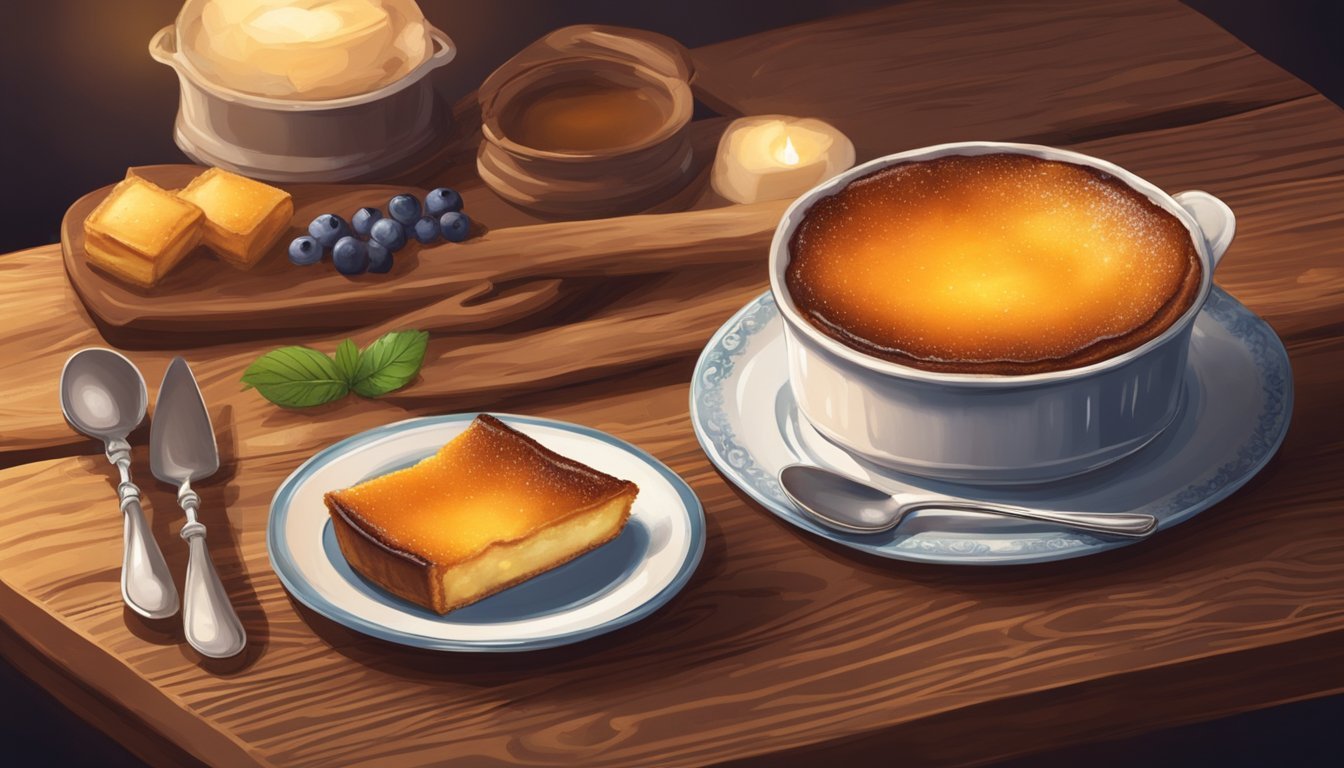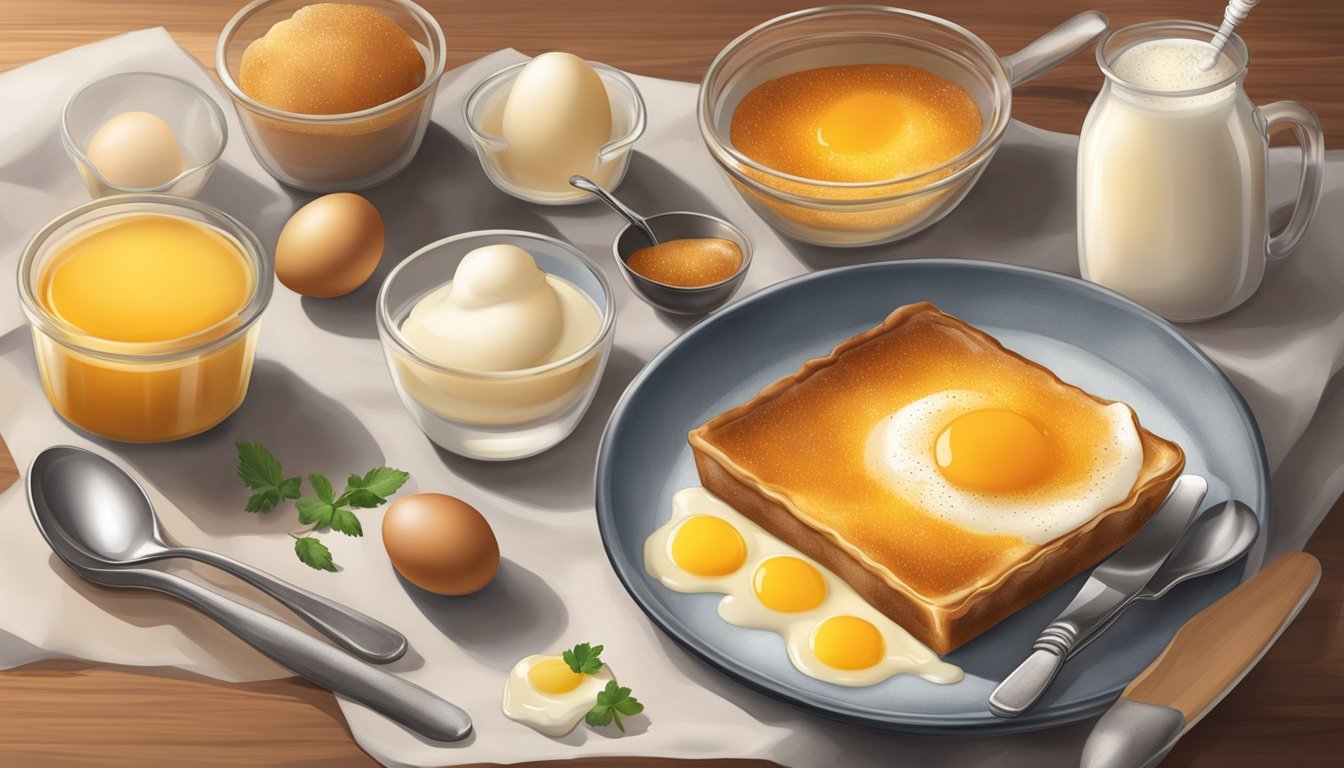Is Creme Brulee Gluten-Free?
Unveiling the Dessert's Composition
Creme brulee is a classic French dessert known for its rich custard base and contrasting layer of hard caramelized sugar. Traditionally, the custard is made with cream, egg yolks, sugar, and vanilla, while the caramelized topping is simply sugar that has been heated until it melts and then hardens upon cooling. The simplicity of its ingredients makes creme brulee a favorite among those who prefer gluten-free options, as none of the core components contain gluten.
Navigating the world of desserts (What wine goes well with desserts?) can be a challenge for individuals with gluten intolerance or celiac disease. However, creme brulee typically stands out as a safe choice. While the standard recipe is naturally gluten-free, caution is advised as some variations or commercial preparations might include gluten-containing ingredients used as thickeners or stabilizers. It is always important to verify ingredient lists or inquire about preparation methods when purchasing store-bought versions or dining out to ensure the dessert remains gluten-free.
As a dessert, creme brulee brings a touch of elegance to the dining table, often served in individual ramekins with a brittle, caramelized topping that diners crack with a spoon. It represents the finesse of French cuisine while accommodating the dietary needs of those avoiding gluten, making creme brulee an exemplary dessert for those seeking both indulgence and peace of mind.
Understanding Creme Brulee
Creme brulee is renowned for its rich custard base and contrasting layer of hard caramelized sugar. This French dessert combines cream, sugar, vanilla, and eggs, which are typically gluten-free ingredients.
History of Creme Brulee
Creme brulee, meaning "burnt cream" in French, has a disputed history with both France and England claiming its origin. However, it is generally accepted as a classic French dessert that dates back to the 17th century. Its distinguishing feature — the caramelized sugar crust — is created by sprinkling sugar atop the custard and then using a culinary torch or a broiler to harden it into a crispy layer.
The dessert's popularity surged following its feature in European cookbooks, such as François Massialot's "Le Cuisinier Royal et Bourgeois" in 1691. Over time, creme brulee has become a staple in French cuisine and a beloved treat worldwide, often flavored with vanilla, one of its signature components.
Gluten-Free Diet Basics
Understanding the fundamentals of a gluten-free diet is critical for those who need to manage celiac disease or gluten sensitivity. It involves recognizing gluten-containing foods and identifying safe alternatives for maintaining a balanced diet.
What Is Gluten?
Gluten is a group of proteins found in certain grains, namely wheat, barley, rye, and variants such as spelt and kamut. It gives dough its elasticity, acting like a glue that holds food together. Gluten can trigger negative health effects in individuals with celiac disease or gluten intolerance.
Common Gluten Sources
Major gluten sources include grains such as:
Wheat (including wheat varieties like spelt, kamut, farro, and durum, plus products like bulgur and semolina)
Barley (commonly found in malt, food coloring, and soups)
Rye (typically in cereals, rye bread, and rye beer)
Additionally, many processed foods contain hidden gluten, making label reading essential.
Gluten-Free Foods
A variety of foods naturally lack gluten and are safe for a gluten-free diet. These include:
Fruits and vegetables
Meats and fish (provided they are not breaded or coated with gluten-containing ingredients)
Dairy products
Grains such as corn, rice, and quinoa
Select oats can be gluten-free if processed in a dedicated facility. It is always important to verify gluten-free labels on such items.
Creme Brulee Ingredients
Creme brulee's delectable simplicity is defined by its few core ingredients: cream, eggs, sugar, and vanilla. These ingredients come together to create a dessert that’s rich and satisfying.
Traditional Ingredients
The classic creme brulee consists of:
Heavy cream: The base of the custard, providing a rich and creamy texture.
Egg yolks: They are responsible for thickening the custard and imparting a velvety richness.
Sugar: Used both within the custard and caramelized on top to create the iconic crisp layer.
Vanilla extract: Offers the dessert its signature, aromatic flavor.
Water: While not mixed into the custard, water is typically used in the baking process, creating a bain-marie to gently cook the mixture to the right consistency.
Gluten Presence in Ingredients
When scrutinizing the typical ingredients for gluten content:
Heavy cream is naturally gluten-free.
Egg yolks are inherently gluten-free elements.
Sugar does not contain gluten.
Vanilla extract is typically gluten-free but it's important to check for cross-contamination if the extraction process uses gluten-containing ingredients.
Wheat and flour, common gluten sources, are not standard in traditional creme brulee recipes. However, the possibility exists that these could be used either to thicken the custard or in the production facilities via cross-contamination. Care should be taken to verify that none of the ingredients were altered with additives containing gluten.
Preparing Gluten-Free Creme Brulee
When preparing gluten-free creme brulee, one must ensure that all ingredients are without gluten and that there is no risk of cross-contamination during the cooking process. Attention to detail in ingredient selection and preparation method is paramount for a successful gluten-free dessert.
Adaptations for Gluten-Free Diet
For individuals following a gluten-free diet, traditional creme brulee can be a suitable dessert option. This classic French custard usually includes gluten-free ingredients such as heavy cream, eggs, sugar, and vanilla. However, it's crucial to avoid potential gluten-containing additives that some manufacturers might include for texture or shelf life.
In instances where gluten-free purity is uncertain, home preparation empowers one to ensure the dessert's safety.
Kitchen surfaces, utensils, and baking equipment should be thoroughly cleaned to prevent gluten cross-contamination.
Ingredient Substitutions
While traditional creme brulee recipes are inherently gluten-free, those who seek dairy alternatives or have additional dietary restrictions may require substitutions. Below is a list of alternative ingredients to customize a gluten-free creme brulee:
Cream: Opt for full-fat coconut milk or almond milk as a dairy-free, gluten-free replacement for heavy cream.
Thickener: Although traditional recipes do not require a thickener due to the egg's natural properties, some recipes may use flour or cornstarch. Ensure to use gluten-free cornstarch or an alternative like ground rice flour if needed.
Standard Ingredient Gluten-Free Alternative Heavy Cream Coconut Milk / Almond Milk Cornstarch Gluten-Free Cornstarch / Rice Flour
Certain adaptations, such as using lactose-free cream or other types of milk, may change the texture or flavor profile of the dessert. It is essential to consider these factors when selecting alternative ingredients for a gluten-free creme brulee.
Gluten-Free Variations of Creme Brulee
Creme Brulee's base recipe is gluten-free, but enthusiasts often seek variations that accommodate additional dietary preferences such as dairy-free, paleo, and vegan diets. Methods and alternative ingredients are carefully selected to ensure the dessert retains its signature texture and flavor.
Dairy-Free and Paleo Options
For those who avoid dairy, a sumptuous alternative to heavy cream is coconut cream. Coconut cream offers a rich, creamy consistency similar to traditional recipes but without the dairy. Paleo-friendly Creme Brulee can be made by substituting regular sugar with maple syrup, which is a natural sweetener allowed in paleo diets. The use of vanilla bean paste is encouraged to impart a robust vanilla flavor that's both dairy-free and paleo-compliant.
Vegan Variations
Vegan versions of Creme Brulee forgo all animal products, including eggs and dairy. The custard can be created using a blend of coconut cream and a vegan thickener, such as agar-agar or arrowroot starch. To sweeten, natural choices like maple syrup can serve as excellent alternatives to refined sugar. Each ingredient is selected to mimic the classic dessert's creamy texture and taste while aligning with a vegan lifestyle.
Creme Brulee Cooking Techniques
Creme Brulee is a dessert known for its rich custard base and a contrasting layer of hard caramel on top. This section explores the specific techniques used to achieve the hallmark features of a well-made Creme Brulee.
Caramelizing Sugar
The signature of Creme Brulee is its caramelized sugar topping, which requires precision. The sugar is evenly sprinkled over the custard and then heated until it melts and forms a hard, golden crust. Chefs often use a blow torch to caramelize the sugar because it provides consistent, controlled heat. The torch is moved in a circular motion to ensure even caramelization without burning the sugar.
Water Bath Method
A water bath, or bain-marie, is crucial for cooking the custard gently and evenly. The custard-filled ramekins are placed in a roasting pan, which is then filled with hot water to about halfway up the sides of the ramekins. This method prevents the custard from curdling or cooking too quickly, which can result in a grainy texture. The water bath also maintains a moist environment in the oven, which is key to the dessert's smooth texture.
Broiling vs. Torch Methods
There are two main approaches to caramelize the sugar on top of Creme Brulee: using the oven's broiler or a kitchen torch. Broiling involves placing the sugar-coated custard under the oven's broiler until the sugar caramelizes. Broiling can be less predictable and requires close attention to prevent burning. On the other hand, using a blow torch allows for more control and speed. The torch crisps the sugar rapidly, giving chefs the ability to create a perfectly caramelized topping with a desirable crunch.
Serving and Presentation
The presentation of Crème Brûlée is as essential as its preparation. The choice of ramekins and garnishes play a pivotal role in delivering an impressive dessert experience.
Choosing the Right Ramekins
Ramekins are not only the molds for cooking Crème Brûlée but also serve as the individual serving dishes. Choosing the right ramekin is crucial for both portion control and heat distribution during the cooking process. They should be oven-proof and shallow to ensure even cooking of the custard. The typical size of a ramekin for Crème Brûlée is about 4 to 6 ounces, allowing for the ideal ratio of caramelized sugar topping to the custard.
Garnishing and Presentation Ideas
Once the Crème Brûlée is cooked and chilled, its garnish should complement both the texture and flavors. A common garnish is a small assortment of fresh berries, such as strawberries or raspberries, which add a refreshing contrast to the rich dessert. For a touch of elegance and extra flavor, one might also consider a light dusting of powdered sugar or a few sprigs of mint. The caramelized sugar topping should be evenly browned and crisp, offering a satisfying crack when gently tapped with a spoon. Ensure the garnish is fresh, and arrange it neatly on top just before serving to maintain its appearance and texture.
Troubleshooting Common Issues
When preparing creme brulee, chefs may encounter issues primarily with the texture of the custard or the caramelization of the sugar topping. Addressing these can enhance both the dessert's delightful consistency and its signature sweet crunch.
Texture Problems
The texture of creme brulee should be smooth and creamy. If it's too runny, this may be due to under-baking. The custard needs to reach a temperature that allows it to set properly, which is usually after about 40 to 45 minutes in the oven at 325°F (163°C). On the other hand, if the custard is too firm, it may have been overbaked. Keeping an eye on the baking time and looking for a slight jiggle in the center of the custard can prevent this issue.
Texture Troubleshooting Tips:
Ensure all ingredients are at a uniform temperature before mixing.
Strain the custard mixture through a fine sieve to remove any lumps for a smoother consistency.
Bake the custard in a water bath to distribute heat evenly.
Caramelization Challenges
The caramelized sugar topping should have a thin, crisp layer that contrasts the creamy custard underneath. If the sugar topping is not caramelizing evenly, the chef may be applying heat unevenly or not using the right type of sugar. Granulated sugar caramelizes best. To achieve the perfect caramelization, one should sprinkle sugar evenly across the custard and use a kitchen torch to melt the sugar until it turns golden brown. If the topping is burning, the torch may be held too close to the sugar; one should maintain an appropriate distance and keep the flame moving in circles.
Caramelization Troubleshooting Tips:
Use a culinary torch rather than a broiler for more controlled caramelization.
Allow the custard to cool completely before adding the sugar to prevent it from melting into the custard.
By following these guidelines, chefs can prevent common problems and ensure that their creme brulee turns out with the ideal texture and sweetness, while keeping a mindful eye on preparation methods and calories.
Where to Find Gluten-Free Creme Brulee
For individuals seeking gluten-free creme brulee, restaurants with dedicated gluten-free menus and grocery stores offering branded pre-made options are reliable sources for enjoying this classic dessert without worry.
Restaurants and Bakeries
Many restaurants and bakeries that are attuned to the needs of customers with dietary restrictions often feature gluten-free creme brulee on their dessert menus. Patrons should inquire if the restaurant has a dedicated gluten-free preparation area to avoid cross-contamination. Some establishments may even hold certifications from recognized gluten-free organizations, ensuring their offerings are safe for those with celiac disease or gluten sensitivity.
Specifics to ask for:
Dedicated gluten-free preparation area
Gluten-free certification
Pre-Made Options at Grocery Stores
At grocery stores, shoppers can find a variety of pre-made gluten-free crème brûlée options. These are often located in the frozen dessert section or advertised as specialty health food items. One should look for clear labeling that specifies the product is gluten-free. Brands often vary by region but may include manufacturers like Deliciously FreeFrom by Sainsbury's or Gluten-Free Cafe from Hain Celestial.
Labels to look for:
"Certified Gluten-Free"
"No Gluten Ingredients"
Additionally, some brands may provide a cautionary label if their products are made in a facility that also processes wheat, which those with celiac disease might want to avoid even if the product itself is gluten-free. Always confirm the label for such details to ensure safety.
Gluten-Free Creme Brulee in Social Media
Social media platforms like Pinterest and Facebook groups provide a hub for gluten-free creme brulee enthusiasts to share recipes and tips. Whether one is looking for a traditional creme brulee recipe with a gluten-free twist or discussions on the best ingredients, these platforms are abundant with information.
Popular Creme Brulee Recipes on Pinterest
Pinterest is a treasure trove of gluten-free creme brulee recipes. Users pin and share their favorite versions of this classic dessert, from the traditional custard to innovative flavor variations.
One can find recipes that substitute ingredients to cater to gluten-free diets, often employing almond flour or cornstarch as alternatives to wheat flour that might be used in some custard bases or as a thickening agent.
The visual nature of Pinterest also helps users to select the most appealing recipes, as images play a crucial role in the popularity of pins.
Discussions on Facebook Groups
On Facebook groups, one can engage in more in-depth discussions about gluten-free creme brulee.
Members often share their success stories and challenges in creating the perfect gluten-free version of the dessert.
Queries about traditional creme brulee recipes that can be adapted to be gluten-free are common, and responses typically include personal experience and advice from other home chefs and experts alike.
The groups can prove to be an invaluable resource when looking for tips on getting that perfect caramelized sugar topping without affecting the gluten-free integrity of the dish.
Final Considerations
When assessing the gluten-free status of crème brûlée, it is critical to consider the core ingredients used and the potential for cross-contamination. It is typically made with inherently gluten-free components; however, vigilance is key for those with gluten-related disorders.
Health Considerations
Gluten-Free Diet: For individuals on a strict gluten-free diet, crème brûlée generally aligns with their dietary restrictions, as it's crafted from gluten-free ingredients like cream, eggs, and sugar. Those with celiac disease or non-celiac gluten sensitivity must ensure that there is no gluten in added stabilizers or via cross-contamination during preparation.
Calories and Nutritional Content: The dessert is high in calories and fat due to the heavy cream and sugar content.
Fat: A significant amount of fat is present, largely from the cream.
Protein: Eggs contribute a modest amount of protein to the dish.
Reader Experiences and Reviews
Readers often express their enjoyment of crème brûlée's creamy texture and rich flavor, which remains uncompromised even when confirming its gluten-free status. Here are typical sentiments:
Positive Review Indicators: Readers appreciate the dessert's luxurious taste and consistency.
Critic Inputs: Food critics usually highlight crème brûlée's balance of sweetness and the satisfying contrast between the creamy base and the caramelized top.
No reports of gluten contamination have notably surfaced among reader reviews, reinforcing the dessert’s gluten-free credibility. However, they advise to always check with the chef or manufacturer, especially when dining out or purchasing pre-made crème brûlée.









